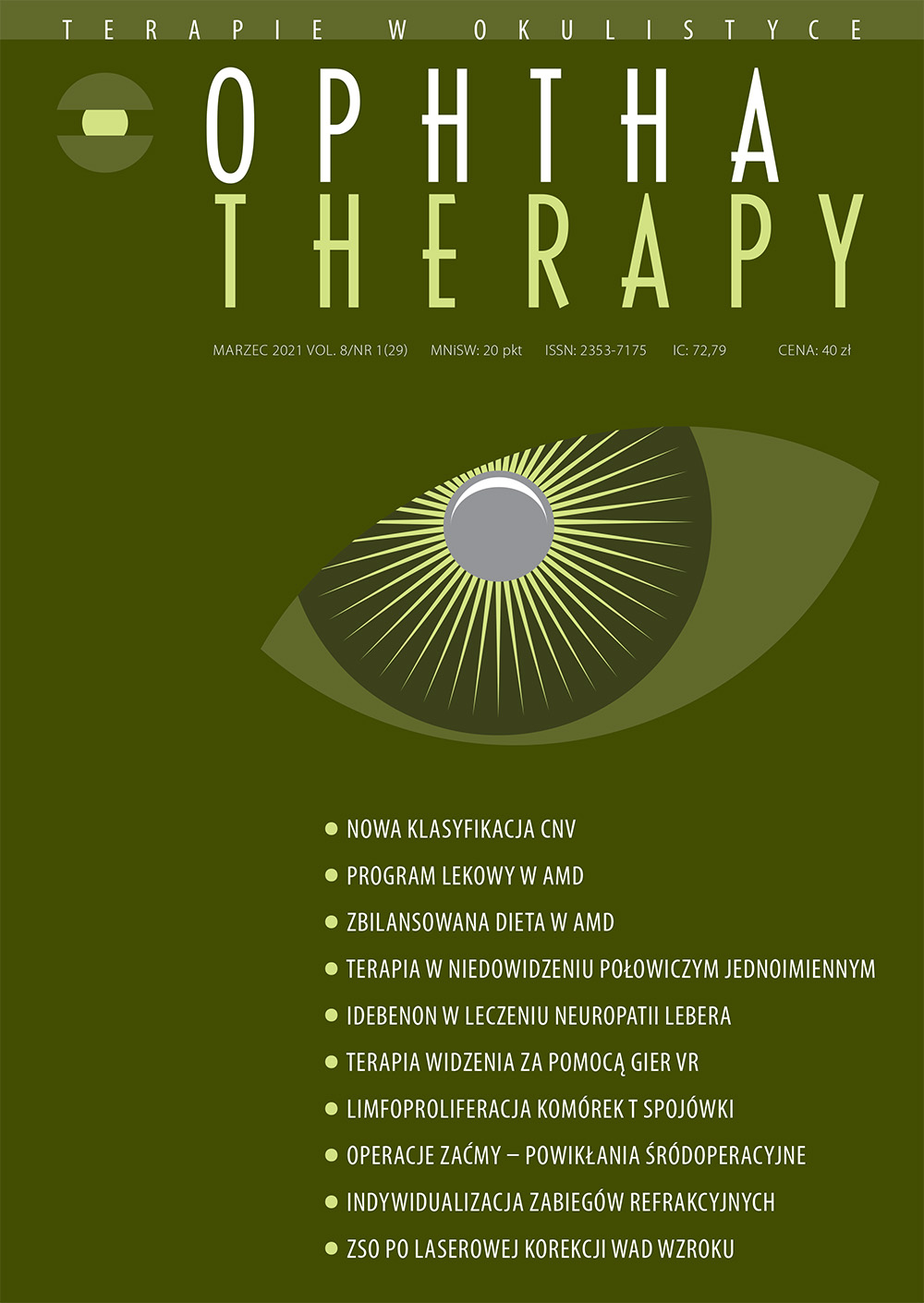Efficacy of visual process improvement in patients with homonymous hemianopia Review article
Main Article Content
Abstract
Homonymous hemianopia is a visual field defect following a stroke, tumor development, traumatic brain injury and other rare causes. Due to the damage to the visual system, lateral neglect occurs that induces difficulties with detecting objects on one side of the binocular visual field, which exposes patients to potential danger during daily activities, especially performed outside – in traffic. Different optical aids such as Fresnel prism have been developed to help those patients by increasing the perception of the affected hemifield. This prism correction can appear in various configurations, for instance: yoked prism, monocular and binocular sector prisms placed with a base to the affected side. The other option to deal with these patients is visual training based on stimulating the affected hemifield.
Downloads
Article Details

This work is licensed under a Creative Commons Attribution-NonCommercial-NoDerivatives 4.0 International License.
Copyright: © Medical Education sp. z o.o. License allowing third parties to copy and redistribute the material in any medium or format and to remix, transform, and build upon the material, provided the original work is properly cited and states its license.
Address reprint requests to: Medical Education, Marcin Kuźma (marcin.kuzma@mededu.pl)
References
2. Zhang X, Kedar S, Lynn MJ et al. Homonymous hemianopias: clinical-anatomic correlations in 904 cases. Neurology. 2006; 66(6): 906-10.
3. Zhang X, Kedar S, Lynn MJ et al. Natural history of homonymous hemianopia. Neurology. 2006; 66(6): 901-5.
4. Bowers AR, Keeney K, Peli E. Community-based trial of a peripheral prism visual field expansion device for hemianopia. Arch Ophthalmol. 2008; 126(5): 657-64.
5. Pambakian AL, Kennard C. Can visual function be restored in patients with homonymous hemianopia? Br J Ophthalmol. 1997; 81(4): 324-8.
6. Schuett S, Heywood CA, Kentridge RW et al. Rehabilitation of hemianopic dyslexia: are words necessary for re-learning oculomotor control? Brain. 2008; 131(12): 3156-68.
7. Pambakian AL, Mannan SK, Hodgson TL et al. Saccadic visual search training: a treatment for patients with homonymous hemianopia. J Neurol Neurosurg Psychiatry. 2004; 75(10): 1443-8.
8. Racette L, Casson EJ. The impact of visual field loss on driving performance: evidence from on-road driving assessments. Optom Vis Sci. 2005; 82(8): 668-74.
9. Lee AG, Perez AM. Improving awareness of peripheral visual field using sectorial prism. J Am Optom Assoc. 1999; 70(10): 624-8.
10. Szlyk JP, Seiple W, Stelmack J et al. Use of prisms for navigation and driving in hemianopic patients. Ophthalmic Physiol Opt. 2005; 25(2): 128-35.
11. Peli E. Field expansion for homonymous hemianopia by optically induced peripheral exotropia. Optom Vis Sci. 2000; 77(9): 453-64.
12. Peli E. Vision multiplexing: an engineering approach to vision rehabilitation device development. Optom Vis Sci. 2001; 78(5): 304-15.
13. Balliet R, Blood KM, Bach-y-Rita P. Visual field rehabilitation in the cortically blind? Neurol Neurosurg Psychiatry. 1985; 48(11): 1113-24.
14. Marsálek P, Santamaría F. Investigating spike backpropagation induced Ca2+ influx in models of hippocampal and cortical pyramidal neurons. Biosystems. 1998; 48(1-3): 147-56.
15. Macias M. Injury induced dendritic plasticity in the mature central nervous system. Acta Neurobiol Exp (Wars). 2008; 68(2): 334-46.
16. Grunda T, Marsalek P, Sykorova P. Homonymous hemianopia and related visual defects: Restoration of vision after a stroke. Acta Neurobiol Exp (Wars). 2013; 73(2): 237-49.
17. Kasten E, Sabel BA. Visual field enlargement after computer training in brain-damaged patients with homonymous deficits: an open pilot trial. Restor Neurol Neurosci. 1995; 8(3): 113-27.
18. Pollock A, Hazelton C, Henderson CA et al. Interventions for visual field defects in patients with stroke. Cochrane Database Syst Rev. 2011; (10): CD008388.
19. Kasten E, Guenther T, Sabel BA. Inverse stimuli in perimetric performance reveal larger visual field defects: implications for vision restoration. Restor Neurol Neurosci. 2008; 26(4-5): 355-64.
20. Julkunen L, Tenovuo O, Jääskeläinen S et al. Rehabilitation of chronic post-stroke visual field defect with computer-assisted training: a clinical and neurophysiological study. Restor Neurol Neurosci. 2003; 21(1-2): 19-28.
21. Zihl J. Visual scanning behavior in patients with homonymous hemianopia. Neuropsychologia. 1995; 33(3): 287-303.
22. Roth T, Sokolov AN, Messias A et al. Comparing explorative saccade and flicker training in hemianopia: a randomized controlled study. Neurology. 2009; 72(4): 324-31.
23. Kerkhoff G. Neurovisual rehabilitation: recent developments and future directions. J Neurol Neurosurg Psychiatry. 2000; 68(6): 691-706.

